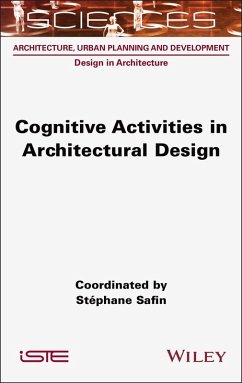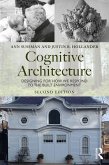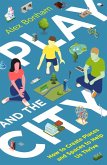Stephane Safin
Cognitive Activities in Architectural Design (eBook, ePUB)
142,99 €
142,99 €
inkl. MwSt.
Sofort per Download lieferbar

0 °P sammeln
142,99 €
Als Download kaufen

142,99 €
inkl. MwSt.
Sofort per Download lieferbar

0 °P sammeln
Jetzt verschenken
Alle Infos zum eBook verschenken
142,99 €
inkl. MwSt.
Sofort per Download lieferbar
Alle Infos zum eBook verschenken

0 °P sammeln
Stephane Safin
Cognitive Activities in Architectural Design (eBook, ePUB)
- Format: ePub
- Merkliste
- Auf die Merkliste
- Bewerten Bewerten
- Teilen
- Produkt teilen
- Produkterinnerung
- Produkterinnerung

Bitte loggen Sie sich zunächst in Ihr Kundenkonto ein oder registrieren Sie sich bei
bücher.de, um das eBook-Abo tolino select nutzen zu können.
Hier können Sie sich einloggen
Hier können Sie sich einloggen
Sie sind bereits eingeloggt. Klicken Sie auf 2. tolino select Abo, um fortzufahren.

Bitte loggen Sie sich zunächst in Ihr Kundenkonto ein oder registrieren Sie sich bei bücher.de, um das eBook-Abo tolino select nutzen zu können.
Architectural design relies on distinct cognitive processes that have been the subject of research for several decades. However, in light of recent social and technological shifts reshaping the discipline, there is a pressing need for new insights to better understand how these changes influence the design process.
This collective work offers an overview of research in the field, opening up perspectives towards an ever-finer understanding of the cognitive processes involved in architectural design: design neuroscience, uses induced or offered by building information modeling (BIM),…mehr
- Geräte: eReader
- mit Kopierschutz
- eBook Hilfe
- Größe: 18.36MB
Andere Kunden interessierten sich auch für
![Cognitive Architecture (eBook, ePUB) Cognitive Architecture (eBook, ePUB)]() Ann SussmanCognitive Architecture (eBook, ePUB)41,95 €
Ann SussmanCognitive Architecture (eBook, ePUB)41,95 €![Play and the City (eBook, ePUB) Play and the City (eBook, ePUB)]() Alex BonhamPlay and the City (eBook, ePUB)3,99 €
Alex BonhamPlay and the City (eBook, ePUB)3,99 €![Urban Environments and Health in the Philippines (eBook, ePUB) Urban Environments and Health in the Philippines (eBook, ePUB)]() Mary Anne Alabanza AkersUrban Environments and Health in the Philippines (eBook, ePUB)39,95 €
Mary Anne Alabanza AkersUrban Environments and Health in the Philippines (eBook, ePUB)39,95 €![Urban Modernity in the Contemporary Gulf (eBook, ePUB) Urban Modernity in the Contemporary Gulf (eBook, ePUB)]() Urban Modernity in the Contemporary Gulf (eBook, ePUB)0,00 €
Urban Modernity in the Contemporary Gulf (eBook, ePUB)0,00 €![Transgressive Design Strategies for Utopian Cities (eBook, ePUB) Transgressive Design Strategies for Utopian Cities (eBook, ePUB)]() Bertug OzarisoyTransgressive Design Strategies for Utopian Cities (eBook, ePUB)39,95 €
Bertug OzarisoyTransgressive Design Strategies for Utopian Cities (eBook, ePUB)39,95 €![Once Upon a China (eBook, ePUB) Once Upon a China (eBook, ePUB)]() Cj LimOnce Upon a China (eBook, ePUB)26,95 €
Cj LimOnce Upon a China (eBook, ePUB)26,95 €![Architectural Technology (eBook, ePUB) Architectural Technology (eBook, ePUB)]() Stephen EmmittArchitectural Technology (eBook, ePUB)44,99 €
Stephen EmmittArchitectural Technology (eBook, ePUB)44,99 €-
-
-
Architectural design relies on distinct cognitive processes that have been the subject of research for several decades. However, in light of recent social and technological shifts reshaping the discipline, there is a pressing need for new insights to better understand how these changes influence the design process.
This collective work offers an overview of research in the field, opening up perspectives towards an ever-finer understanding of the cognitive processes involved in architectural design: design neuroscience, uses induced or offered by building information modeling (BIM), information retrieval, representational processes, AI in ideation, and the values and processes used in active participation.
Cognitive Activities in Architectural Design is aimed at researchers in the design sciences seeking a deeper understanding of design processes, architectural teachers looking to reflect on and enhance their teaching practices, and practitioners interested in how scientific research can define and conceptualize their professional work.
This collective work offers an overview of research in the field, opening up perspectives towards an ever-finer understanding of the cognitive processes involved in architectural design: design neuroscience, uses induced or offered by building information modeling (BIM), information retrieval, representational processes, AI in ideation, and the values and processes used in active participation.
Cognitive Activities in Architectural Design is aimed at researchers in the design sciences seeking a deeper understanding of design processes, architectural teachers looking to reflect on and enhance their teaching practices, and practitioners interested in how scientific research can define and conceptualize their professional work.
Dieser Download kann aus rechtlichen Gründen nur mit Rechnungsadresse in D ausgeliefert werden.
Produktdetails
- Produktdetails
- Verlag: John Wiley & Sons
- Seitenzahl: 437
- Erscheinungstermin: 9. September 2025
- Englisch
- ISBN-13: 9781394411207
- Artikelnr.: 75429844
- Verlag: John Wiley & Sons
- Seitenzahl: 437
- Erscheinungstermin: 9. September 2025
- Englisch
- ISBN-13: 9781394411207
- Artikelnr.: 75429844
- Herstellerkennzeichnung Die Herstellerinformationen sind derzeit nicht verfügbar.
Stéphane Safin is Professor of Cognitive Ergonomics and Work Psychology at Université Libre de Bruxelles, Belgium, and Télécom Paris (Institut Polytechnique de Paris), France. His research focuses on the analysis of ideation and participation activities in design and architecture.
Introduction xi
Stéphane SAFIN
Chapter 1 Exploring Neurocognition in Design 1
Julie MILOVANOVIC
1.1 Towards a holistic approach to the description of cognitive design
processes: cognition and neurocognition 3
1.2 Tools and methods for exploring the neurocognition of design activity 4
1.2.1 Tools: EEG, fMRI and fNIRS 4
1.2.2 Experimental techniques 5
1.2.3 Analysis methods 7
1.2.4 Regions of interest associated with design activity 9
1.3 Neurocognition of design processes: how far have we come? 12
1.3.1 What are the neurocognitive differences between design tasks and
constrained problem solving? 13
1.3.2 Impact of using different idea generation techniques on the
neurocognition of ideation 16
1.3.3 Creativity, divergent and convergent thinking 17
1.3.4 Hyperscanning as a technique for exploring the neurocognition of
collaborative design 21
1.4 Neurocognition of design processes: what are the limits? 23
1.5 Outlook 24
1.5.1 Benefits and challenges for designers 24
1.5.2 Interests and challenges for researchers in design sciences 25
1.5.3 Benefits and challenges for design teachers 26
1.6 Conclusion 26
1.7 References 26
Chapter 2 Mobilizing Values in the Design Process 37
Françoise DÉTIENNE, Chloé LE BAIL and Michael BAKER
2.1 Introduction 37
2.2 Value-based approaches to design 38
2.2.1 Values: definitions 38
2.2.2 Moral and/or ethical values 39
2.2.3 Values embedded in design artifacts: a well-documented issue 41
2.2.4 Values in the design process: where do they fit in? 41
2.2.5 Challenges around design values 43
2.3 Participatory housing: a socio-technical system with strong social
values 45
2.3.1 History and definition of participatory housing 45
2.3.2 Values in participatory housing projects 46
2.3.3 Values in the artifact codesign process 48
2.4 Discussion 51
2.5 Conclusion 52
2.6 References 53
Chapter 3 Graphic Representations in Design and Participation 59
Stéphane SAFIN
3.1 Introduction 59
3.2 External cognition 60
3.3 Cognitive functions of external representations 63
3.3.1 Lightening the mental load 63
3.3.2 Structuring behavior 65
3.3.3 Materializing information 66
3.3.4 Extending cognitive abilities 68
3.4 Design representations as mediators of collaborative design activity 69
3.5 Towards a typology of architectural representations 72
3.6 Freehand sketching as a special case in design activities 76
3.7 Synchronic and diachronic articulations of forms of representation:
towards the notion of a system of representations 78
3.8 Representations: a central issue in participation 82
3.8.1 The challenges of co-creation 84
3.8.2 Towards the construction of hybrid representation systems for
co-creation 85
3.9 Conclusion 89
3.10 References 90
Chapter 4 Information Retrieval in Architectural Design and Parametric
Modeling 99
Thomas DISSAUX and Stéphane SAFIN
4.1 Introduction 99
4.2 Information retrieval 100
4.2.1 Information retrieval for learning purposes 103
4.3 Information retrieval in design 105
4.3.1 C-k 106
4.3.2 Fbs 109
4.3.3 Information, inspiration, fixation 111
4.4 The role of tools 116
4.4.1 Parametric design 119
4.4.2 New forms of design induced by PDEs 120
4.4.3 Outlook for education 125
4.5 Conclusion 126
4.6 References 128
Chapter 5 Citizen Participation in Design: Roles Evolving in the Face of
Contemporary Challenges 135
Clémentine SCHELINGS
5.1 Theory and critique of participatory design 136
5.1.1 Towards participatory design 136
5.1.2 Designers: a profession undergoing upheaval 148
5.1.3 On the user side: changing roles 152
5.2 Evolving roles and contemporary issues in participatory design 159
5.2.1 Understanding the complementary roles of designers and users 160
5.2.2 A new role for participation professionals 164
5.2.3 A new role for user ambassadors 167
5.2.4 Other contemporary issues linked to new forms of digital
participation 171
5.3 Conclusion 173
5.4 Acknowledgments 174
5.5 References 174
Chapter 6 The Collaborative Challenges of Digitizing Construction
Information: The Case of BIM 183
Anabelle RAHHAL, Samia BEN RAJEB and Pierre LECLERCQ
6.1 Introduction 183
6.2 Digitalization of construction 185
6.3 BIM for 4.0 construction 186
6.3.1 Towards collaborative management of building information 186
6.3.2 BIM maturity levels 187
6.3.3 Current response trends 190
6.3.4 Limits of the technocentric approach 196
6.3.5 The challenges of collaboration in BIM 198
6.4 Conclusion 201
6.5 References 203
Chapter 7 People Information Modeling: The Potential of BIM for
Human-Centred Design 213
Panos MAVROS
7.1 Introduction 213
7.2 Four design challenges 214
7.3 Context: the notion of building usability 216
7.4 A three-part framework 218
7.4.1 Approach 1: simulating human behavior 219
7.4.2 Approach 2: virtual reality, integrating users 222
7.4.3 Approach 3: building lifecycle and operation 225
7.4.4 Approach 4: a macroperspective on the built environment 226
7.5 Perspectives 227
7.6 References 228
Chapter 8 Architectural Ideation Instrumented by GAI 233
Gizem YÜKSEK and Aurélie DE BOISSIEU
8.1 Introduction: challenges and opportunities of artificial intelligence
(AI) for architectural design and ideation 233
8.2 Modes of interaction with GAIs 235
8.2.1 Introduction to GAIs and the specifics of prompts 235
8.2.2 Text-to-text: text content generation 236
8.2.3 Text-and-image-to-image: image generation 237
8.2.4 Image generation settings 238
8.3 Uses and potential uses of GAIs 239
8.3.1 Exploring architectural "styles" 239
8.3.2 Exploring materials 240
8.3.3 Exploring combinations of ideas 242
8.3.4 Exploring architectural morphology 243
8.3.5 Exploring ambiences 246
8.4 Cognitive processes at work in AI-instrumented ideation 248
8.4.1 Divergence strategies 248
8.4.2 Convergence strategies 250
8.4.3 Meaningful indeterminacy and letting go 251
8.4.4 Fixation 251
8.4.5 Alternating convergence and divergence 253
8.5 Internalization and externalization dynamics supported by GAIs 255
8.5.1 The central role of the prompt 255
8.5.2 Iterations between text and image prompts 255
8.5.3 A dynamic process of internalization and externalization 257
8.5.4 A cross-computational design 258
8.6 Conclusion 259
8.7 References 261
List of Authors 265
Index 267
Stéphane SAFIN
Chapter 1 Exploring Neurocognition in Design 1
Julie MILOVANOVIC
1.1 Towards a holistic approach to the description of cognitive design
processes: cognition and neurocognition 3
1.2 Tools and methods for exploring the neurocognition of design activity 4
1.2.1 Tools: EEG, fMRI and fNIRS 4
1.2.2 Experimental techniques 5
1.2.3 Analysis methods 7
1.2.4 Regions of interest associated with design activity 9
1.3 Neurocognition of design processes: how far have we come? 12
1.3.1 What are the neurocognitive differences between design tasks and
constrained problem solving? 13
1.3.2 Impact of using different idea generation techniques on the
neurocognition of ideation 16
1.3.3 Creativity, divergent and convergent thinking 17
1.3.4 Hyperscanning as a technique for exploring the neurocognition of
collaborative design 21
1.4 Neurocognition of design processes: what are the limits? 23
1.5 Outlook 24
1.5.1 Benefits and challenges for designers 24
1.5.2 Interests and challenges for researchers in design sciences 25
1.5.3 Benefits and challenges for design teachers 26
1.6 Conclusion 26
1.7 References 26
Chapter 2 Mobilizing Values in the Design Process 37
Françoise DÉTIENNE, Chloé LE BAIL and Michael BAKER
2.1 Introduction 37
2.2 Value-based approaches to design 38
2.2.1 Values: definitions 38
2.2.2 Moral and/or ethical values 39
2.2.3 Values embedded in design artifacts: a well-documented issue 41
2.2.4 Values in the design process: where do they fit in? 41
2.2.5 Challenges around design values 43
2.3 Participatory housing: a socio-technical system with strong social
values 45
2.3.1 History and definition of participatory housing 45
2.3.2 Values in participatory housing projects 46
2.3.3 Values in the artifact codesign process 48
2.4 Discussion 51
2.5 Conclusion 52
2.6 References 53
Chapter 3 Graphic Representations in Design and Participation 59
Stéphane SAFIN
3.1 Introduction 59
3.2 External cognition 60
3.3 Cognitive functions of external representations 63
3.3.1 Lightening the mental load 63
3.3.2 Structuring behavior 65
3.3.3 Materializing information 66
3.3.4 Extending cognitive abilities 68
3.4 Design representations as mediators of collaborative design activity 69
3.5 Towards a typology of architectural representations 72
3.6 Freehand sketching as a special case in design activities 76
3.7 Synchronic and diachronic articulations of forms of representation:
towards the notion of a system of representations 78
3.8 Representations: a central issue in participation 82
3.8.1 The challenges of co-creation 84
3.8.2 Towards the construction of hybrid representation systems for
co-creation 85
3.9 Conclusion 89
3.10 References 90
Chapter 4 Information Retrieval in Architectural Design and Parametric
Modeling 99
Thomas DISSAUX and Stéphane SAFIN
4.1 Introduction 99
4.2 Information retrieval 100
4.2.1 Information retrieval for learning purposes 103
4.3 Information retrieval in design 105
4.3.1 C-k 106
4.3.2 Fbs 109
4.3.3 Information, inspiration, fixation 111
4.4 The role of tools 116
4.4.1 Parametric design 119
4.4.2 New forms of design induced by PDEs 120
4.4.3 Outlook for education 125
4.5 Conclusion 126
4.6 References 128
Chapter 5 Citizen Participation in Design: Roles Evolving in the Face of
Contemporary Challenges 135
Clémentine SCHELINGS
5.1 Theory and critique of participatory design 136
5.1.1 Towards participatory design 136
5.1.2 Designers: a profession undergoing upheaval 148
5.1.3 On the user side: changing roles 152
5.2 Evolving roles and contemporary issues in participatory design 159
5.2.1 Understanding the complementary roles of designers and users 160
5.2.2 A new role for participation professionals 164
5.2.3 A new role for user ambassadors 167
5.2.4 Other contemporary issues linked to new forms of digital
participation 171
5.3 Conclusion 173
5.4 Acknowledgments 174
5.5 References 174
Chapter 6 The Collaborative Challenges of Digitizing Construction
Information: The Case of BIM 183
Anabelle RAHHAL, Samia BEN RAJEB and Pierre LECLERCQ
6.1 Introduction 183
6.2 Digitalization of construction 185
6.3 BIM for 4.0 construction 186
6.3.1 Towards collaborative management of building information 186
6.3.2 BIM maturity levels 187
6.3.3 Current response trends 190
6.3.4 Limits of the technocentric approach 196
6.3.5 The challenges of collaboration in BIM 198
6.4 Conclusion 201
6.5 References 203
Chapter 7 People Information Modeling: The Potential of BIM for
Human-Centred Design 213
Panos MAVROS
7.1 Introduction 213
7.2 Four design challenges 214
7.3 Context: the notion of building usability 216
7.4 A three-part framework 218
7.4.1 Approach 1: simulating human behavior 219
7.4.2 Approach 2: virtual reality, integrating users 222
7.4.3 Approach 3: building lifecycle and operation 225
7.4.4 Approach 4: a macroperspective on the built environment 226
7.5 Perspectives 227
7.6 References 228
Chapter 8 Architectural Ideation Instrumented by GAI 233
Gizem YÜKSEK and Aurélie DE BOISSIEU
8.1 Introduction: challenges and opportunities of artificial intelligence
(AI) for architectural design and ideation 233
8.2 Modes of interaction with GAIs 235
8.2.1 Introduction to GAIs and the specifics of prompts 235
8.2.2 Text-to-text: text content generation 236
8.2.3 Text-and-image-to-image: image generation 237
8.2.4 Image generation settings 238
8.3 Uses and potential uses of GAIs 239
8.3.1 Exploring architectural "styles" 239
8.3.2 Exploring materials 240
8.3.3 Exploring combinations of ideas 242
8.3.4 Exploring architectural morphology 243
8.3.5 Exploring ambiences 246
8.4 Cognitive processes at work in AI-instrumented ideation 248
8.4.1 Divergence strategies 248
8.4.2 Convergence strategies 250
8.4.3 Meaningful indeterminacy and letting go 251
8.4.4 Fixation 251
8.4.5 Alternating convergence and divergence 253
8.5 Internalization and externalization dynamics supported by GAIs 255
8.5.1 The central role of the prompt 255
8.5.2 Iterations between text and image prompts 255
8.5.3 A dynamic process of internalization and externalization 257
8.5.4 A cross-computational design 258
8.6 Conclusion 259
8.7 References 261
List of Authors 265
Index 267
Introduction xi
Stéphane SAFIN
Chapter 1 Exploring Neurocognition in Design 1
Julie MILOVANOVIC
1.1 Towards a holistic approach to the description of cognitive design
processes: cognition and neurocognition 3
1.2 Tools and methods for exploring the neurocognition of design activity 4
1.2.1 Tools: EEG, fMRI and fNIRS 4
1.2.2 Experimental techniques 5
1.2.3 Analysis methods 7
1.2.4 Regions of interest associated with design activity 9
1.3 Neurocognition of design processes: how far have we come? 12
1.3.1 What are the neurocognitive differences between design tasks and
constrained problem solving? 13
1.3.2 Impact of using different idea generation techniques on the
neurocognition of ideation 16
1.3.3 Creativity, divergent and convergent thinking 17
1.3.4 Hyperscanning as a technique for exploring the neurocognition of
collaborative design 21
1.4 Neurocognition of design processes: what are the limits? 23
1.5 Outlook 24
1.5.1 Benefits and challenges for designers 24
1.5.2 Interests and challenges for researchers in design sciences 25
1.5.3 Benefits and challenges for design teachers 26
1.6 Conclusion 26
1.7 References 26
Chapter 2 Mobilizing Values in the Design Process 37
Françoise DÉTIENNE, Chloé LE BAIL and Michael BAKER
2.1 Introduction 37
2.2 Value-based approaches to design 38
2.2.1 Values: definitions 38
2.2.2 Moral and/or ethical values 39
2.2.3 Values embedded in design artifacts: a well-documented issue 41
2.2.4 Values in the design process: where do they fit in? 41
2.2.5 Challenges around design values 43
2.3 Participatory housing: a socio-technical system with strong social
values 45
2.3.1 History and definition of participatory housing 45
2.3.2 Values in participatory housing projects 46
2.3.3 Values in the artifact codesign process 48
2.4 Discussion 51
2.5 Conclusion 52
2.6 References 53
Chapter 3 Graphic Representations in Design and Participation 59
Stéphane SAFIN
3.1 Introduction 59
3.2 External cognition 60
3.3 Cognitive functions of external representations 63
3.3.1 Lightening the mental load 63
3.3.2 Structuring behavior 65
3.3.3 Materializing information 66
3.3.4 Extending cognitive abilities 68
3.4 Design representations as mediators of collaborative design activity 69
3.5 Towards a typology of architectural representations 72
3.6 Freehand sketching as a special case in design activities 76
3.7 Synchronic and diachronic articulations of forms of representation:
towards the notion of a system of representations 78
3.8 Representations: a central issue in participation 82
3.8.1 The challenges of co-creation 84
3.8.2 Towards the construction of hybrid representation systems for
co-creation 85
3.9 Conclusion 89
3.10 References 90
Chapter 4 Information Retrieval in Architectural Design and Parametric
Modeling 99
Thomas DISSAUX and Stéphane SAFIN
4.1 Introduction 99
4.2 Information retrieval 100
4.2.1 Information retrieval for learning purposes 103
4.3 Information retrieval in design 105
4.3.1 C-k 106
4.3.2 Fbs 109
4.3.3 Information, inspiration, fixation 111
4.4 The role of tools 116
4.4.1 Parametric design 119
4.4.2 New forms of design induced by PDEs 120
4.4.3 Outlook for education 125
4.5 Conclusion 126
4.6 References 128
Chapter 5 Citizen Participation in Design: Roles Evolving in the Face of
Contemporary Challenges 135
Clémentine SCHELINGS
5.1 Theory and critique of participatory design 136
5.1.1 Towards participatory design 136
5.1.2 Designers: a profession undergoing upheaval 148
5.1.3 On the user side: changing roles 152
5.2 Evolving roles and contemporary issues in participatory design 159
5.2.1 Understanding the complementary roles of designers and users 160
5.2.2 A new role for participation professionals 164
5.2.3 A new role for user ambassadors 167
5.2.4 Other contemporary issues linked to new forms of digital
participation 171
5.3 Conclusion 173
5.4 Acknowledgments 174
5.5 References 174
Chapter 6 The Collaborative Challenges of Digitizing Construction
Information: The Case of BIM 183
Anabelle RAHHAL, Samia BEN RAJEB and Pierre LECLERCQ
6.1 Introduction 183
6.2 Digitalization of construction 185
6.3 BIM for 4.0 construction 186
6.3.1 Towards collaborative management of building information 186
6.3.2 BIM maturity levels 187
6.3.3 Current response trends 190
6.3.4 Limits of the technocentric approach 196
6.3.5 The challenges of collaboration in BIM 198
6.4 Conclusion 201
6.5 References 203
Chapter 7 People Information Modeling: The Potential of BIM for
Human-Centred Design 213
Panos MAVROS
7.1 Introduction 213
7.2 Four design challenges 214
7.3 Context: the notion of building usability 216
7.4 A three-part framework 218
7.4.1 Approach 1: simulating human behavior 219
7.4.2 Approach 2: virtual reality, integrating users 222
7.4.3 Approach 3: building lifecycle and operation 225
7.4.4 Approach 4: a macroperspective on the built environment 226
7.5 Perspectives 227
7.6 References 228
Chapter 8 Architectural Ideation Instrumented by GAI 233
Gizem YÜKSEK and Aurélie DE BOISSIEU
8.1 Introduction: challenges and opportunities of artificial intelligence
(AI) for architectural design and ideation 233
8.2 Modes of interaction with GAIs 235
8.2.1 Introduction to GAIs and the specifics of prompts 235
8.2.2 Text-to-text: text content generation 236
8.2.3 Text-and-image-to-image: image generation 237
8.2.4 Image generation settings 238
8.3 Uses and potential uses of GAIs 239
8.3.1 Exploring architectural "styles" 239
8.3.2 Exploring materials 240
8.3.3 Exploring combinations of ideas 242
8.3.4 Exploring architectural morphology 243
8.3.5 Exploring ambiences 246
8.4 Cognitive processes at work in AI-instrumented ideation 248
8.4.1 Divergence strategies 248
8.4.2 Convergence strategies 250
8.4.3 Meaningful indeterminacy and letting go 251
8.4.4 Fixation 251
8.4.5 Alternating convergence and divergence 253
8.5 Internalization and externalization dynamics supported by GAIs 255
8.5.1 The central role of the prompt 255
8.5.2 Iterations between text and image prompts 255
8.5.3 A dynamic process of internalization and externalization 257
8.5.4 A cross-computational design 258
8.6 Conclusion 259
8.7 References 261
List of Authors 265
Index 267
Stéphane SAFIN
Chapter 1 Exploring Neurocognition in Design 1
Julie MILOVANOVIC
1.1 Towards a holistic approach to the description of cognitive design
processes: cognition and neurocognition 3
1.2 Tools and methods for exploring the neurocognition of design activity 4
1.2.1 Tools: EEG, fMRI and fNIRS 4
1.2.2 Experimental techniques 5
1.2.3 Analysis methods 7
1.2.4 Regions of interest associated with design activity 9
1.3 Neurocognition of design processes: how far have we come? 12
1.3.1 What are the neurocognitive differences between design tasks and
constrained problem solving? 13
1.3.2 Impact of using different idea generation techniques on the
neurocognition of ideation 16
1.3.3 Creativity, divergent and convergent thinking 17
1.3.4 Hyperscanning as a technique for exploring the neurocognition of
collaborative design 21
1.4 Neurocognition of design processes: what are the limits? 23
1.5 Outlook 24
1.5.1 Benefits and challenges for designers 24
1.5.2 Interests and challenges for researchers in design sciences 25
1.5.3 Benefits and challenges for design teachers 26
1.6 Conclusion 26
1.7 References 26
Chapter 2 Mobilizing Values in the Design Process 37
Françoise DÉTIENNE, Chloé LE BAIL and Michael BAKER
2.1 Introduction 37
2.2 Value-based approaches to design 38
2.2.1 Values: definitions 38
2.2.2 Moral and/or ethical values 39
2.2.3 Values embedded in design artifacts: a well-documented issue 41
2.2.4 Values in the design process: where do they fit in? 41
2.2.5 Challenges around design values 43
2.3 Participatory housing: a socio-technical system with strong social
values 45
2.3.1 History and definition of participatory housing 45
2.3.2 Values in participatory housing projects 46
2.3.3 Values in the artifact codesign process 48
2.4 Discussion 51
2.5 Conclusion 52
2.6 References 53
Chapter 3 Graphic Representations in Design and Participation 59
Stéphane SAFIN
3.1 Introduction 59
3.2 External cognition 60
3.3 Cognitive functions of external representations 63
3.3.1 Lightening the mental load 63
3.3.2 Structuring behavior 65
3.3.3 Materializing information 66
3.3.4 Extending cognitive abilities 68
3.4 Design representations as mediators of collaborative design activity 69
3.5 Towards a typology of architectural representations 72
3.6 Freehand sketching as a special case in design activities 76
3.7 Synchronic and diachronic articulations of forms of representation:
towards the notion of a system of representations 78
3.8 Representations: a central issue in participation 82
3.8.1 The challenges of co-creation 84
3.8.2 Towards the construction of hybrid representation systems for
co-creation 85
3.9 Conclusion 89
3.10 References 90
Chapter 4 Information Retrieval in Architectural Design and Parametric
Modeling 99
Thomas DISSAUX and Stéphane SAFIN
4.1 Introduction 99
4.2 Information retrieval 100
4.2.1 Information retrieval for learning purposes 103
4.3 Information retrieval in design 105
4.3.1 C-k 106
4.3.2 Fbs 109
4.3.3 Information, inspiration, fixation 111
4.4 The role of tools 116
4.4.1 Parametric design 119
4.4.2 New forms of design induced by PDEs 120
4.4.3 Outlook for education 125
4.5 Conclusion 126
4.6 References 128
Chapter 5 Citizen Participation in Design: Roles Evolving in the Face of
Contemporary Challenges 135
Clémentine SCHELINGS
5.1 Theory and critique of participatory design 136
5.1.1 Towards participatory design 136
5.1.2 Designers: a profession undergoing upheaval 148
5.1.3 On the user side: changing roles 152
5.2 Evolving roles and contemporary issues in participatory design 159
5.2.1 Understanding the complementary roles of designers and users 160
5.2.2 A new role for participation professionals 164
5.2.3 A new role for user ambassadors 167
5.2.4 Other contemporary issues linked to new forms of digital
participation 171
5.3 Conclusion 173
5.4 Acknowledgments 174
5.5 References 174
Chapter 6 The Collaborative Challenges of Digitizing Construction
Information: The Case of BIM 183
Anabelle RAHHAL, Samia BEN RAJEB and Pierre LECLERCQ
6.1 Introduction 183
6.2 Digitalization of construction 185
6.3 BIM for 4.0 construction 186
6.3.1 Towards collaborative management of building information 186
6.3.2 BIM maturity levels 187
6.3.3 Current response trends 190
6.3.4 Limits of the technocentric approach 196
6.3.5 The challenges of collaboration in BIM 198
6.4 Conclusion 201
6.5 References 203
Chapter 7 People Information Modeling: The Potential of BIM for
Human-Centred Design 213
Panos MAVROS
7.1 Introduction 213
7.2 Four design challenges 214
7.3 Context: the notion of building usability 216
7.4 A three-part framework 218
7.4.1 Approach 1: simulating human behavior 219
7.4.2 Approach 2: virtual reality, integrating users 222
7.4.3 Approach 3: building lifecycle and operation 225
7.4.4 Approach 4: a macroperspective on the built environment 226
7.5 Perspectives 227
7.6 References 228
Chapter 8 Architectural Ideation Instrumented by GAI 233
Gizem YÜKSEK and Aurélie DE BOISSIEU
8.1 Introduction: challenges and opportunities of artificial intelligence
(AI) for architectural design and ideation 233
8.2 Modes of interaction with GAIs 235
8.2.1 Introduction to GAIs and the specifics of prompts 235
8.2.2 Text-to-text: text content generation 236
8.2.3 Text-and-image-to-image: image generation 237
8.2.4 Image generation settings 238
8.3 Uses and potential uses of GAIs 239
8.3.1 Exploring architectural "styles" 239
8.3.2 Exploring materials 240
8.3.3 Exploring combinations of ideas 242
8.3.4 Exploring architectural morphology 243
8.3.5 Exploring ambiences 246
8.4 Cognitive processes at work in AI-instrumented ideation 248
8.4.1 Divergence strategies 248
8.4.2 Convergence strategies 250
8.4.3 Meaningful indeterminacy and letting go 251
8.4.4 Fixation 251
8.4.5 Alternating convergence and divergence 253
8.5 Internalization and externalization dynamics supported by GAIs 255
8.5.1 The central role of the prompt 255
8.5.2 Iterations between text and image prompts 255
8.5.3 A dynamic process of internalization and externalization 257
8.5.4 A cross-computational design 258
8.6 Conclusion 259
8.7 References 261
List of Authors 265
Index 267







